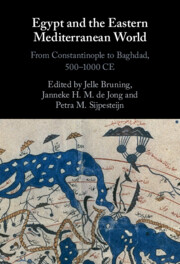Book contents
- Egypt and the Eastern Mediterranean World
- Egypt and the Eastern Mediterranean World
- Copyright page
- Contents
- Figures, Graphs, and Tables
- Notes on Contributors
- Notes on Transliteration, Names, and Dates
- Preface and Acknowledgments
- Additional material
- Introduction
- Part I Political and Administrative Connections
- Chapter 1 Egypt in the Age of Justinian: Connector or Disconnector?
- Chapter 2 At the Crossroads of Regional Settings: Egypt, 500–1000 CE
- Chapter 3 The Frontier Zone at the First Cataract before and at the Time of the Muslim Conquest (Fifth to Seventh Centuries)
- Chapter 4 Islamic Historiography on Early Muslim Relations with Nubia
- Chapter 5 Local Tradition and Imperial Legal Policy under the Umayyads: The Evolution of the Early Egyptian School of Law
- Chapter 6 Ibn Ṭūlūn’s Pacification Campaign: Sedition, Authority, and Empire in Abbasid Egypt
- Part II Economic Connections
- Part III Social and Cultural Connections
- Index
- References
Chapter 3 - The Frontier Zone at the First Cataract before and at the Time of the Muslim Conquest (Fifth to Seventh Centuries)
from Part I - Political and Administrative Connections
Published online by Cambridge University Press: 01 December 2022
- Egypt and the Eastern Mediterranean World
- Egypt and the Eastern Mediterranean World
- Copyright page
- Contents
- Figures, Graphs, and Tables
- Notes on Contributors
- Notes on Transliteration, Names, and Dates
- Preface and Acknowledgments
- Additional material
- Introduction
- Part I Political and Administrative Connections
- Chapter 1 Egypt in the Age of Justinian: Connector or Disconnector?
- Chapter 2 At the Crossroads of Regional Settings: Egypt, 500–1000 CE
- Chapter 3 The Frontier Zone at the First Cataract before and at the Time of the Muslim Conquest (Fifth to Seventh Centuries)
- Chapter 4 Islamic Historiography on Early Muslim Relations with Nubia
- Chapter 5 Local Tradition and Imperial Legal Policy under the Umayyads: The Evolution of the Early Egyptian School of Law
- Chapter 6 Ibn Ṭūlūn’s Pacification Campaign: Sedition, Authority, and Empire in Abbasid Egypt
- Part II Economic Connections
- Part III Social and Cultural Connections
- Index
- References
Summary
A discussion of Egypt’s incorporation into the larger structures of an emerging Muslim empire should also touch upon the question when Egypt, from north to south, was entirely under Muslim dominion in the seventh century.1 Whereas the Muslim literary sources provide plenty of information about the conquest of the Nile Delta, and to some extent also that of Middle Egypt,2 our knowledge of the situation at the southern limes of the Byzantine empire, the last bastion to fall to the Muslims, is still very incomplete. How effective was the border defense in this strategic area – against enemies from both the south and the north? Was the Byzantine empire indeed not able to defend this part against aggressors? But why then, according to literary sources, could the Muslims only take Aswān in 652, a decade after the conquest of northern Egypt?
- Type
- Chapter
- Information
- Egypt and the Eastern Mediterranean WorldFrom Constantinople to Baghdad, 500-1000 CE, pp. 73 - 102Publisher: Cambridge University PressPrint publication year: 2022
References
Bibliography
Eide, Tormod, Hägg, Tomas, Pierce, Richard Holton and Török, László. Fontes Historiae Nubiorum: Textual Sources for the History of the Middle Nile Region between the Eighth Century BC and the Sixth Century AD, vol. 3: From the First to the Sixth Century AD. Bergen: University of Bergen, 1998.
Bernand, Étienne. Les inscriptions Grecques et Latines de Philae. Paris: Éditions du Centre National de la Recherche Scientifique, 1969.
Martindale, J. R. The Prosopography of the Later Roman Empire, vol. 2: AD 395–527. London: Cambridge University Press, 1980.



